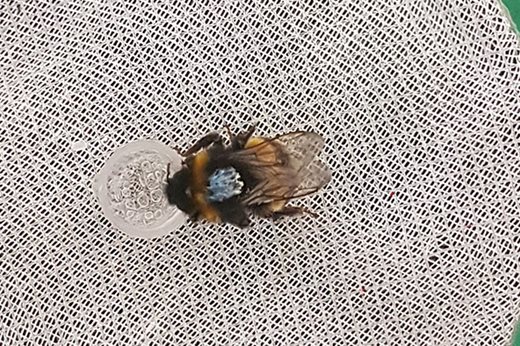 Each bee colony and every bee within it has its own character. Getting to know a new bee colony is always a real treat. I work with the bees at the University of Cambridge in partnership with the RHS to answer questions about plant disease and evolution.
Each bee colony and every bee within it has its own character. Getting to know a new bee colony is always a real treat. I work with the bees at the University of Cambridge in partnership with the RHS to answer questions about plant disease and evolution.
Painted bees
Before experiments can even start I spend hours watching bees. When one leaves the colony and goes straight to the top of a feeding tower this bee has potential! In order to be able to identify this bee again in the future I mark its back with a little water-soluble paint. This is easier said than done and certainly requires a bit of practice. Although the paint doesn’t harm the bee and some don’t seem to mind, others, perhaps understandably, don’t enjoy the process at all.
Sometimes bees start to try to clean themselves straightaway before the paint is dry. They use their front legs to try to clean themselves, wiping the neat little dot that I have painted from their thorax and smearing it across their legs and face. They can end up looking quite a mess. Sometimes they fly upwards towards the Perspex ceiling of the arena before the paint is dry, bouncing along it leaving a trail of coloured dots – some of the artwork they produce is quite striking.
Not all busy bees
As soon as I have some bees marked, the colony changes from a swarm of anonymous insects to a complex group of individuals as each marked bee reveals their character. Some are great foragers, leaving the nest box and going into the arena to feed from the sugar water we provide and carrying it back to feed their mother and sisters in the colony. They repeatedly buzz back and forth making many trips in a day. These are the ones that are likely to be best at doing the experiments that I have planned. Others sit around in the flight arena drinking sugar water lazily or congregating in corners being generally a bit useless.
I can’t help but name the bees, usually based on the colours that they have been painted; Christmas Bee for example is a green and red bee, Sunset Bee for an orange, yellow and red bee and Big Yellow, well you get the idea.
Once the bees are used to feeding from sugar water on the top of feeding towers and I have identified some good foragers it is time to start experiments. I shut the door to the nest box allowing bees to go in but not out until the arena is empty. Any that don’t fancy going back into the next box in a timely manner must be trapped under pots while the experiments take place. I only want one bee in the arena at a time so that each bee can make independent choices not influenced by other bees.
The waiting game
I place clean feeding towers in the arena, hidden under which are tomato plants, some of which have been sprayed with natural plant products that induce symptoms resembling infection with a plant virus. The plants are hidden from view so that the bees can smell the plants but not see them. It is then a waiting game, watching the entrance to the nest for a painted bee that I know to be a good forager. When one appears I let it out into the arena and watch it carefully to see which feeding towers it visits. I mark down whether it visits the towers containing treated or untreated plants to see whether it has a preference.
I need each bee to make 10 choices, a bee will often return to the nest before making 10 choices as they usually get full of sugar water after two or three choices. This isn’t usually a problem however as it will come usually come out again once it has deposited its bounty into the nest ready to collect more.
By understanding how bees interact with diseased plants I hope to be able to understand more about how viruses change plant biochemistry to manipulate insects and help their spread. I couldn’t do this without my team of tiny scientist bees.
Read more
Plants for pollinators
Learn mre about plants that encourage pollinating insects such as bees into your garden.
Help the bees
How gardeners can help the falling bee population.

